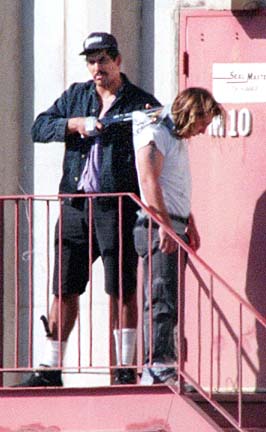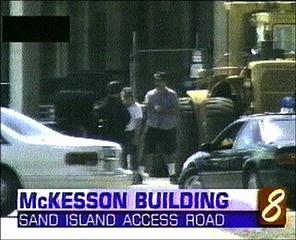The following CNN article pertains to the John Miranda hostage crisis that occured on February 6, 1996 - just off Sand Island Access Road in Honolulu Hawaii.
Tei Gordon and his father Richard were held captive in the adjoining office during the eight-hour standoff with police.
Richard Gordon shot video of the crisis from a hostage perspective and sold it to KHNL News.
Read on...
----------------------------------------------------------------------CNN----
Honolulu gunman shot by police Hostage safe as 6-hour standoff ends
February 6, 1996
Web posted at: 8:45 p.m. ESTHONOLULU, Hawaii (CNN) -- More than six hours after a dramatic hostage situation began, police sharpshooters shot and wounded a man who had kept one end of a sawed off shotgun taped to his hand and the other attached to the neck of a hostage.
The suspect had said the gun was rigged to fire if he was shot, but the hostage suffered only minor cuts to his head and hands when police opened fire.
Both men were taken to a hospital. The condition of the gunman was unclear, but he had been shot in the chest, according to medics.
At about 7:30 p.m. EST, out of the range of news cameras, about six shots rang out and ambulances converged on the parking lot of the office where the suspect once worked and had held the hostage for about seven hours.
At one point, the sharpshooters came within inches of the gunman, who had identified himself as John Miranda, a former employee of Seal Masters, a company that makes sealers for concrete products.
The situation began inside Seal Masters about 1:30 p.m. EST, when Miranda allegedly took five people hostage. Witnesses and members of his family said Miranda had worked at the company but had been fired recently.
The gunman let three people go unharmed, but another hostage was shot in the leg while exiting the building from a window about 15 feet off the ground. It was unclear whether the hostage was trying to escape or was pushed out the window.
That hostage, identified by people on the scene as a supervisor named Guy George, was taken to the hospital and was listed in critical condition.
Local TV cameras captured George in the window with a gun to his head and then falling, his leg bleeding, from the window.
The gunman's brother said he thought George was the vice president of the company.
Donald Rodriguez told a local radio station his brother had "no job, no money, no house, a kid ... what do you expect somebody to do?" He pleaded with police to let him talk to his brother, but they refused.
When the shots rang out, news cameras showed Rodriguez trying to get to his brother. He was tackled and taken away by police.
The gunman held the hostage on the outside stairs for a while before coming down into parking lot, where he came within inches of police SWAT teams and sharpshooters. After a few minutes, he and the hostage went back and sat on the stairs.
The company is housed in the McKesson building, along with about 20 other businesses, all of which were evacuated. The building is in an industrial district near Honolulu International Airport.
-------------------------------------------------------Honolulu
Star Bulletin------

KEN SAKAMOTO /
KSAKAMOTO@STARBULLETIN.COM
Ken Sakamoto was on the scene in February 1996, when John Miranda terrorized workers at Seal Masters of Honolulu, a waterproofing company on Sand Island Access Road. Miranda taped a shotgun to employee Tom McNeil's neck and held McNeil hostage for hours as he negotiated with police. Miranda was eventually shot and killed by police; McNeil escaped.
================================================
It is kind of difficult to tell from the picture above, but the gunman has taped his right finger to the trigger and the end of the barrel to the hostages neck. Therefore, if shot, reflexes would automatically pull the trigger and... well, you get the point.
Apparently the gunman got the idea off of an episode of Hawaii Five-O.
The events that unfolded were truly tragic and understanding the preceeding events that antagonized the gunman really makes one understand that it was not entirely his fault.
Read more in the archives of the Honolulu Star Bulletin
